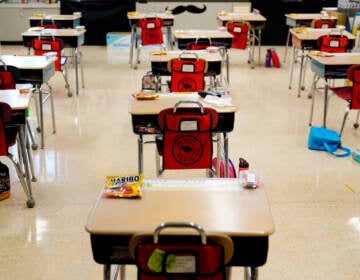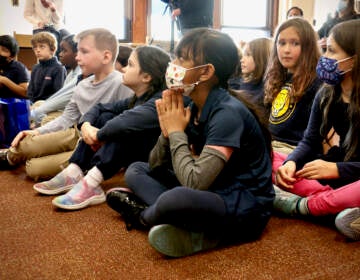Some Philly schools want to use outdoor classrooms when IRL lessons resume
While Philadelphia School District students won't return to classrooms until at least November, some principals are already thinking about how to use outdoor learning spaces.
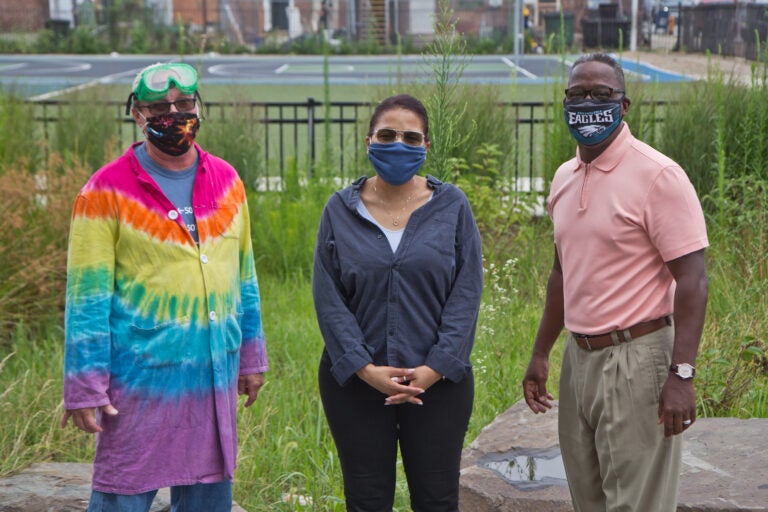
Patterson Elementary Principal Kenneth Jessup (right), with second grade teacher Marjorie Thomas (center), and K-4 science teacher John Steczak (left), at the area next to the school where outdoor class is planned to take place. (Kimberly Paynter/WHYY)
On a typical school day at John M. Patterson School in Southwest Philadelphia, the playground would be busy with kids shooting hoops, chatting at tables — and learning about race-car propulsion or the ecology of the schoolyard plantings.
With a basketball court, running track, and a rain garden edged with stones, the yard at the 500-student campus serves not only as a play space but also as an outdoor classroom. The space debuted in 2018, replacing a hard asphalt surface. Already, it has contributed to a major improvement in the school climate: in the first year, in-school suspensions dropped from 50 per year to zero, Principal Kenneth Jessup said.
Like all Philadelphia School District schools, Jessup’s will restart virtually in September and operate 100% online until Nov. 17 at the earliest.
But Jessup and other principals fortunate to have outdoor classrooms on their campuses are already thinking about how these spaces could be reimagined when students eventually return to on-campus instruction. These educators and other advocates note that the transmission risk for the virus that causes COVID-19 is lower outdoors than indoors and that, in any case, holding classes outside is known to have measurable benefits for children. For Jessup, there is no reason not to take advantage of the amenity when the time comes.
“As long as I can get the right equipment out there, I know my teachers are willing to do it. It would be a different mood that I think would be an advantage … and of course avoiding transmission of COVID,” Jessup said.
As of now, the School District has no plans to create new outdoor classes; officials are focused on getting remote classrooms up and running for the fall. “We will continue to consult with public health experts to determine if outdoor activities aligned to courses may occur,” district spokesperson Monica Lewis said in an email.
But if local schools do move more activities outside they will be joining a global trend. Denmark, for example, put a heavy emphasis on outdoor learning when it reopened primary schools in April as part of its aggressive and successful anti-COVID strategy. Italian schools are experimenting with outdoor teaching, especially for younger children. Scotland’s children’s minister endorsed the idea, as did the World Health Organization.
In the U.S., education activists in California and Washington D.C. are pushing for their districts to do more instruction outdoors. There are historical precedents as well. During a tuberculosis epidemic in the early 20th century, schools in Rhode Island and New York created open-air classrooms or held classes on roofs or ferries, in some cases bundling up students in heavy blankets when outdoor temperatures dropped.
The case for outdoor classrooms
In Philadelphia, outdoor classrooms have long been a priority when school communities set out to redesign their schoolyards, said Owen Franklin, Pennsylvania State Director at The Trust for Public Land. TPL built Patterson’s playground and has spearheaded construction of many parks and play spaces in the city.
Children love to be outside and many teachers relish the opportunity to engage their students in new ways. Principals appreciate the addition of new learning space to their crowded campuses, and the larger community benefits by having a recreational area they can use in the afternoon and on weekends, Franklin said.
“Even if COVID had never happened, the tremendous benefits they can provide alone are so compelling. We see now a new, timely, urgent reason why those schoolyards are valuable for enabling schools to have greater flexibility and greater capacity during times of increased constraints and challenge,” he said.
Jessup has seen how the change of setting helps teachers reach students. Given that experience, he is eager to have more outdoor instruction when his school reopens for in-person instruction.
“It thrills me, because we have kind of started that a little bit, and I see the excitement in the kids. They see it as a treat, so to speak. They’re kind of engaged a little bit more,” he said.
A few miles from Patterson, the playground at Chester Arthur School in Southwest Center City has a number of special features, thanks to an ambitious fundraising campaign driven by parents and the school administration. Students follow a pathway bordered with native grasses and other plants, an artificial hill that serves as a small amphitheater, a sundial, and an “outdoor boulder classroom.” Before the lockdown sent kids home for virtual learning in March, teachers regularly took their students outside for physical education, robotics and natural science classes.
“It’s really only limited by the teacher’s imagination,” Principal Mary Libby said. “On a given day, you might see kindergarten students thinking about the senses and walking in different zones of the schoolyard. Over in the grasses, what do they hear, see, touch, feel, as opposed to another section?”
Before the pandemic, her staff was already discussing new ways to use the schoolyard and three interior courtyards. More recently, as they prepared to possibly have children on campus again, those conversations became much more focused, she said.
They talked about practical details like setting up sunshades and rain covers, as well as whiteboards and furniture needed for math, language and other classes that are typically held indoors.
“Previously we were thinking, ‘hey, how can we create outdoor classrooms out of these courtyards?’ But now it’s acutely, ‘how can we do this?’ Maybe scale it down and make it as safe as possible so pods of students can rotate through, and get some outdoor space and some breathing space?” Libby said.
Outdoor classrooms can create challenges. Jessup said Patterson parents would sometimes walk by during classes and try to talk to their kids, causing a distraction. His schoolyard saw some minor vandalism in the first year, which stopped after he talked to community members and a neighbor agreed to keep an eye on the playground.
But he said the bigger obstacles are the safety mandates and uncertainties created by the pandemic. The district is planning to have all-online classes initially and then, possibly, to switch to part-time in-person classes in November. But it remains to be seen if COVID case counts remain stable, what health authorities will allow, and whether further innovation will be possible amid a continual scramble to redesign school operations.
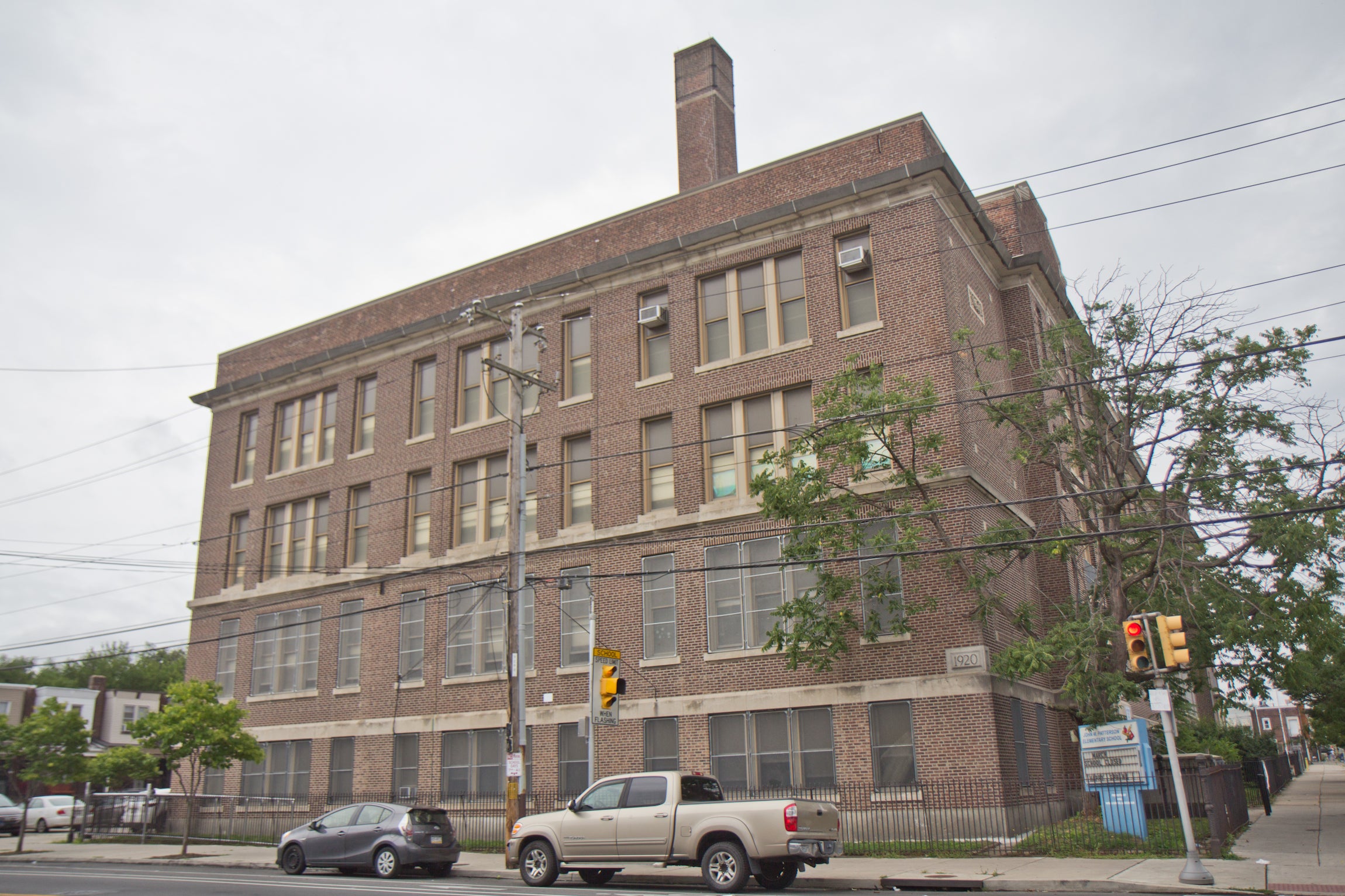
The question of whether to pursue outdoor learning has been clearer for schools with more resources and freedom to try new methods.
William Penn Charter, a private pre-K-12 Quaker school on 47 acres in East Falls, started working on the outdoor aspects of its reopening plan months ago. The school arranged to rent 11 large tents to use as classrooms, lunchrooms, downtime hangout areas, and flex space, said Travis Larrabee, the director of strategic initiatives.
“We’re trying to create spaces with as much flexibility as possible. We’ll have floors in these tents, but you can also open the flaps and get the natural air flow, which is highly recommended, obviously, in terms of the disease spread,” he said.
Penn Charter has a long tradition of outdoor learning and recreation, Larrabee said. The campus has a playground, artificial turf fields, grassy areas, gardens, a beekeeping site, and an outdoor stage where students have put on Shakespeare plays. It’s at the border of the Wissahickon and Schuylkill watersheds, giving students easy access to kayaking, ornithology classes and ecology projects.
Face-to-face relationships and connections are hallmarks of the school experience that administrators want to maintain this fall if possible, while safeguarding the health of their 960 students and of all the teachers and other adults on campus, Larrabee said.
While it invested substantial time preparing teachers for online instruction, the school is determinedly pursuing outdoor learning opportunities — in addition to masking, small class sizes, screening protocols, and improved window ventilation and HVAC systems — so in-person learning can resume, he said.
“We have a greater competence to be able to deliver our program from a distance, but we still know that being on campus is what we want,” Larrabee said. “Safety first and foremost, but we want to try to get our students on campus as much as we can, if we’re allowed to and we can do it safely.”
Editor’s Note: This article was updated on July 31, 2020

Subscribe to PlanPhilly
WHYY is your source for fact-based, in-depth journalism and information. As a nonprofit organization, we rely on financial support from readers like you. Please give today.




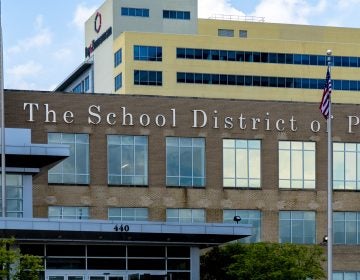

![CoronavirusPandemic_1024x512[1]](https://whyy.org/wp-content/uploads/2020/03/CoronavirusPandemic_1024x5121-300x150.jpg)
